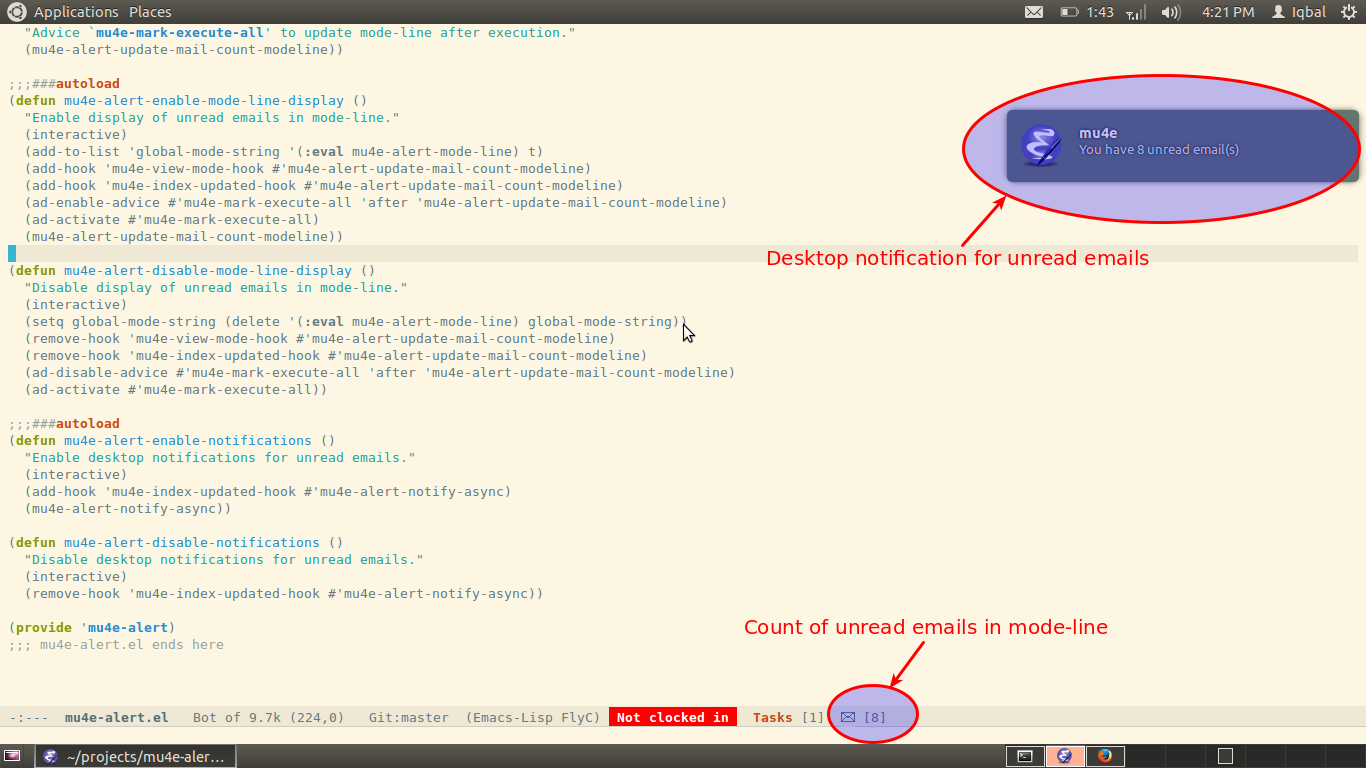Mark up code that is mentioned in the documentation of some readmes.
In the case of “long options”, like for example `--with-emacs`, this is not just
cosmetic. On GitHub, Org files are apparently rendered in such a way that
strings like `--` in non-verbatim text (i.e. not verbatim-quoted nor
code-quoted) is transformed to `–` (EN DASH U+2013). So the string:
… --with-emacs option:
Will show up like this:
… –with-emacs option:
Also mark up nearby not-marked-up code mentions. But this pattern was what was
searched for, so this mostly changes the abovementioned kind of thing.
|
||
|---|---|---|
| .. | ||
| config.el | ||
| funcs.el | ||
| packages.el | ||
| README.org | ||
Mu4e layer
Install
In order to use this layer you must install mu and mu4e separately. Typically mu4e will be bundled with mu (this is the case on many Linux distributions).
If you're on OS X and install mu using Homebrew, you must specify the
location of your Emacs binary at install time using the EMACS environment
variable, as well as passing the --with-emacs option:
brew install mu --with-emacs
If the installation directory of mu4e is not in Emacs’ load path, you can set
the layer variable mu4e-installation-path, for example:
(setq-default dotspacemacs-configuration-layers
'((mu4e :variables
mu4e-installation-path "/usr/share/emacs/site-lisp")))
Then add this layer to your ~/.spacemacs. You will need to add mu4e to the
existing dotspacemacs-configuration-layers list in this file.
Commands
Global bindings
| Keybinding | Command |
|---|---|
SPC a M |
Start mu4e |
Headers mode
| Keybinding | Command |
|---|---|
J |
Go to next unread thread marking other mail read on the way |
C-j |
Next header |
C-k |
Previous header |
View mode
| Keybinding | Command |
|---|---|
J |
Go to next unread thread marking other mail read on the way |
C-j |
Next header |
C-k |
Previous header |
Configuration
Configuration varies too much to give precise instructions. What follows is one example configuration. Refer to mu4e's manual for more detailed configuration instructions.
Maildirs extension
The maildirs extension adds a list of all your maildirs to the main mu4e view that by default shows the unread and total mail counts for all your mail under your base mail directory.
This extension is enabled by default, you can deactivate (and uninstall) it by
adding the package = to your dotfile variable =dotspacemacs-excluded-packages.
Multiple Accounts
This layer includes support for multiple sending accounts.
If you have only one account you do not need to define this variable.
If you have multiple accounts, configure the mu4e-account-alist variable:
(setq mu4e-account-alist
'(("gmail"
;; Under each account, set the account-specific variables you want.
(mu4e-sent-messages-behavior delete)
(mu4e-sent-folder "/gmail/[Gmail]/.Sent Mail")
(mu4e-drafts-folder "/gmail/[Gmail]/.Drafts")
(user-mail-address "billy@gmail.com")
(user-full-name "Billy"))
("college"
(mu4e-sent-messages-behavior sent)
(mu4e-sent-folder "/college/Sent Items")
(mu4e-drafts-folder "/college/Drafts")
(user-mail-address "bb15@college.edu")
(user-full-name "Billy Bob 15"))))
(mu4e/mail-account-reset)
The first account listed will be the default account, so variables like
user-full-name, which is used by other parts of Emacs, will have their value
reset for the default account after sending each email.
Note that the mu4e layer expects mu4e-account-alist to be defined before the
layer is loaded. For example, you can set mu4e-account-alist to a dummy
setting in dotspacemacs/layers:
(mu4e :variables mu4e-account-alist t)
and then actually set mu4e-account-alist later in dotspacemacs/user-config.
Make sure you call mu4e/mail-account-reset afterward, which will initialize
the given account variables.
If you have mu 0.9.16 or later, you can use mu4e's built-in contexts feature instead (see mu4e's manual).
Example configuration
;;; Set up some common mu4e variables
(setq mu4e-maildir "~/.mail"
mu4e-trash-folder "/Trash"
mu4e-refile-folder "/Archive"
mu4e-get-mail-command "mbsync -a"
mu4e-update-interval nil
mu4e-compose-signature-auto-include nil
mu4e-view-show-images t
mu4e-view-show-addresses t)
;;; Mail directory shortcuts
(setq mu4e-maildir-shortcuts
'(("/gmail/INBOX" . ?g)
("/college/INBOX" . ?c)))
;;; Bookmarks
(setq mu4e-bookmarks
`(("flag:unread AND NOT flag:trashed" "Unread messages" ?u)
("date:today..now" "Today's messages" ?t)
("date:7d..now" "Last 7 days" ?w)
("mime:image/*" "Messages with images" ?p)
(,(mapconcat 'identity
(mapcar
(lambda (maildir)
(concat "maildir:" (car maildir)))
mu4e-maildir-shortcuts) " OR ")
"All inboxes" ?i)))Notifications
mu4e-alert is an extension that provides desktop notifications and adds the
count of unread messages to the modeline.

For an extended documentation of the available customizations please refer to mu4e-alert's documentation
OS notifications
To enable notifications about new messages, add the following line to your
dotspacemacs/user-config:
(setq mu4e-enable-notifications t)
or use layer variables when you add the layer to
dotspacemacs-configuration-layers:
(mu4e :variables mu4e-enable-notifications t)
By default, notifications will be shown in the *Messages* buffer. To enable
desktop notifications about new messages, add the following lines to
your dotspacemacs/user-config, according to your operating system and the
installed libraries:
(with-eval-after-load 'mu4e-alert
;; Enable Desktop notifications
(mu4e-alert-set-default-style 'notifications)) ; For linux
;; (mu4e-alert-set-default-style 'libnotify)) ; Alternative for linux
;; (mu4e-alert-set-default-style 'notifier)) ; For Mac OSX (through the
; terminal notifier app)
;; (mu4e-alert-set-default-style 'growl)) ; Alternative for Mac OSXMode-line notifications
To enable mode-line display about new messages, add the following line to
your dotspacemacs/user-config:
(setq mu4e-enable-mode-line t)
or use layer variables when you add the layer to
dotspacemacs-configuration-layers:
(mu4e :variables mu4e-enable-mode-line t)Spacemacs layout integration
A Spacemacs custom layout is defined by the layer. The name and the key binding for it can be customized with the following layer variables:
mu4e-spacemacs-layout-namefor the layout name,mu4e-spacemacs-layout-bindingfor the key binding.
By default the values are:
(setq-default dotspacemacs-configuration-layers '(
(mu4e :variables mu4e-spacemacs-layout-name "@Mu4e"
mu4e-spacemacs-layout-binding "m")))See also
Refer to the official mu and mu4e documentation for additional info.